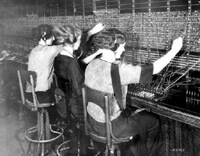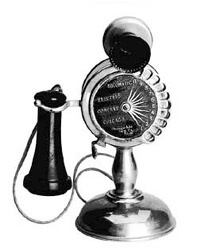Telecommunications History Group Resources
The Science of Phones
How Phones Work - The Science of Phones
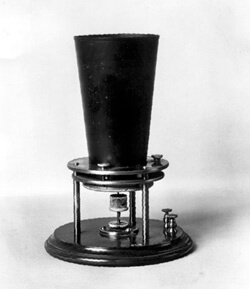
Liquid transmitter, over which the first articulate sentence (“Mr. Watson, come here! I want you!”) was spoken over an electric telephone, on March 10, 1876 (THG file photo).
“Hey! Is this thing on?!”
Before diving into the workings of the very earliest phones, let’s talk about how they work in general. After all, the phones of today work the same way as Bell’s and all the phones of yesteryear. Sure, the trappings are different; we use computers instead of operators, air instead of wires to transmit our voices, but the premise behind all of it is the same—so much so, in fact, that you could hook up a phone from the early 1900s to your wall and still get it to work!
A basic phone consists of a microphone (which you talk into), an apparatus to change your voice into electric signals, a means of sending the signals to their destination (say, your friend’s ear), and (on your friend’s end) a receiver which then changes the electric signals back into your voice (or an approximation thereof).
But how on earth does your voice get changed into electricity? This is really the heart of the matter, for once you can change your voice into electric current and then change it back again, you’ve got it made (you just need wires or some medium to transmit the electricity). The key is something called “variable resistance.”
Inspired by a Dead Man’s Ear
In 1874, while Alexander Graham Bell (who considered himself to be a teacher of the deaf, more than the inventor of the telephone) was working on the harmonic telegraph, the telephone, and hearing aids for the deaf, he built a device called a phonoautograph, made with Frankensteinian ingenuity out of a dead man’s ear. (It is not recorded just where the ear came from, volunteered or otherwise.) Speaking into the device caused the ear to operate, well, like an ear: The ear’s membrane vibrated according to the intensity of the voice, more for louder voices or sounds, less for quieter sounds or whispers. This in turn caused a lever attached to the ear to “write” a wave pattern on smoked glass—bigger waves for louder sounds and smaller for quieter sounds. This inspired Bell. He thought that, just maybe, by using a membrane to convert sounds of varying intensity into electrical current of varying intensity (instead of just the working of a lever), and then reversing the process on the other end with another membrane, he could replicate speech over long distances. It took him two years to put this idea into practice, but it became the founding principle of telephony.
The first working telephones using this principle used a liquid to create the variable resistance. You would speak downward into a tube; this would cause a membrane (a small disk made of metal) to move and vibrate according to the intensity of the sounds in your voice. In some models the membrane was further attached to a steel rod, which would be pushed down (and pulled up) by the vibrations. The rod would move up and down in a cup of electrified acid water (this is why you had to speak downward into the device; spills would be very bad!), changing the resistance, and thus sending a variable current out through a wire to a receiver on the other end. In other Bell models, the transmitter was dropped and the whole thing was powered by the voice of the person using the phone (through weak electromagnetic power created through the use of magnets).
Specializing in Carbon
The human voice couldn’t create enough power to make telephones practical; a call of over a few miles was impossible, even with stronger magnets. In 1877, Thomas Edison (yes, the Thomas Edison of lighting and other fame) designed and patented a new transmitter, one utilizing a special property of carbon.
Carbon is special because it changes its electrical conductivity with minimal amounts of pressure—pressure such as that created by pressing a membrane against it, a membrane that is vibrating due to, oh, say, the sound waves created by a human voice. This allowed the same basic setup as Bell’s, but without the difficulty of using a cup of battery acid and with much greater capacity (when used in conjunction with outside power) for distance and clarity. The carbon-based transmitter (and receiver, for that matter) was used in phones until relatively recently (the 1970s), and in fact can be found in many home phones still in use today.
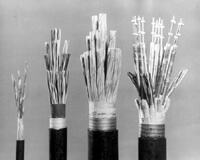
“Modern” cable – the three on the left are all twisted pair; the one on the right is coaxial (THG file photo).
Wiring
Once you’ve generated the variable current, it has to have some way to get to your friend on the receiving end so that their receiver can change the current back to sounds. From the beginning (or nearly the beginning), copper wire has been the carrier of choice, although recently fiber optic cables and, of course, wireless (through radio waves) carriers have come to the fore.
How many wires do you need? You could try just one wire, carrying both your voice and your friend’s, and grounding each end in the earth to complete the circuit. The first phones did just this, using an iron wire just like a telegraph would use. This created a lot of static, however, since everyone was using the earth to ground their phones. This was soon fixed when Bell invented a two-wire, or metallic, circuit in 1881. This meant that your phone conversation would require two wires, one to your friend and the other back, creating a complete circuit and thus not needing to be grounded in the earth, and also giving you a clearer conversation.
This meant, of course, replacing all the existing telephone wires with two-wire systems, but it was done by about 1900, and all new lines were two-wire lines. At the same time, manufacturers were looking for ways to reduce static and line noise through the material used to conduct the electricity for phone conversations. Combinations such as phosphor bronze and copper steel wires were tried, but just didn’t quite work well enough for general use. Copper by itself wasn’t strong enough to be used in overhead lines, even though it was known to be a very good conductor. Then, in 1877 Thomas Doolittle of Connecticut developed the process for hard drawn copper wire, which increased its tensile strength and made it strong enough for overhead wires.
The wires were insulated with cotton, cotton impregnated with paraffin, gutta percha or a rubber compound (and much later—in the 1950s—with PVC). By the late 1800s, these wires were twisted around one another (creating what is called “twisted pair” wiring). The twisting provides some protection against picking up interference from other wires nearby, and from interference generally.
Although the simple copper twisted pair wiring is still used in many areas today, there are many other methods of transmitting voices—and data—that are faster and/or more convenient, including fiber optic cables, microwaves (like the ones in your oven, but, well, different—see further info by clicking here), and radio waves. This last is how cordless and cell phones operate (more on that in our article “How Cordless and Cell Phones Work”).
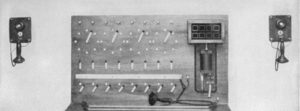
Model of the first commercial telephone switchboard, installed in New Haven, Connecticut in 1878 (from Beginnings of Telephony by Frederick Leland Rhodes, Harper & Brothers, 1929).
Switchboards and Druggists and Doctors
OK, so now we know all about converting our voices into electrical current, and how that current then moves down a wire and eventually gets reconverted into sound, which our friend hears and becomes the stuff of which conversations are born. But how does the current from our voice know to get to our friend?
This is easy as long as there are no other telephones besides ours and our friend’s (that is, one friend only!); the wire is connected from our phone to hers, and that’s that. But what if we want to be connected to several of our friends?
Well, again this is fairly easy if we don’t care how many of our friends hear our conversation. Just connect phone wires to everyone’s phone, more or less directly, splitting from your first connection with your original friend. Then everyone can hear the conversation—all they have to do is pick up their phone. This was really the case (more-or-less) for a lot of communities during the course of telephone history, and was known as a party line. Great, if you want a mass phone call, like a giant joke email sent to all your friends. Not so good if you have to tell someone something private, like, say, if you work for a secret organization.
In July 1877 a druggist in Hartford, Connecticut, wanted to be able to connect with several different doctors around town, and so he installed the first switchboard in his office. Soon this became a feature of all phone company central offices. A switchboard, in very basic terms, acts as the hub of all telephone activity. Your phone line, as well as everyone else’s, was connected to the switchboard in the main office, as opposed to being connected directly with any one person. An operator would sit at the switchboard and use small pieces of wire to connect (that is, complete the circuit) between yourself and, say, friend number one. You would literally call the operator for any call you wanted to make.
Say I wanted to call Friend One (oh, let’s call her Josephine). I would pick up my handset and the phone hook would complete a circuit, alerting the operator that I had picked up the phone. I would tell the operator that I wanted to talk to Josephine, and the operator would then connect my phone wire with Josephine’s. (Well, technically, she might first ring Josephine to make sure my friend was there to receive calls, and then connect us.) Better than a party line, as the only person possibly listening in would be the operator. Still not incredibly private, though. (As an aside, did you know that the first operators were teenage boys, who often engaged in horseplay and foul language? Telephone companies soon began hiring “girls” in order to present a more genteel image to customers, and thus the tradition of operators being almost exclusively women began. See a related exhibit at telcomhistory.org.)Operators and Undertakers
An undertaker by the name of Almon Strowger in Kansas City, Missouri, had this same concern—or, rather, a similar one. He felt that the operators were connecting his potential clients with his competitors in an attempt to drive him out of business, so he (with help from various technicians) invented a device using electromagnets and hat pins in 1891 that made the connection between two parties without help from a human operator. A caller would tap out the number they wanted on keys, which would signal various “selector” rods (which looked much like windshield wipers) in the home office to make electrical contacts with specific paths, which would eventually connect you with the person you were calling.
This type of switching worked fairly well, although it required the caller to press a “release” button when the call was finished and did not take into account being connected to an already busy line. These flaws were soon fixed, however, and soon a dial replaced the keys (see more about the dials themselves a little further down this page).
Strowger and his associates M. A. Meyer and Joseph Harris set up the Strowger Automatic Telephone Company on October 30, 1891, and a year later they installed the world’s first automatic exchange in La Porte, Indiana.
Despite this, semi-automatic and automatic phone switching systems did not enter the major phone market until 1914 in Newark, NJ (semi-automatic) and 1921 in Omaha, NE (automatic). In fact, automatic switching was limited to local calls for the entire first half of the 20th century.
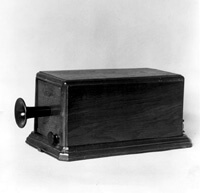
Box telephone with Watson’s Thumper. The 1877 telephone had the first signaling device, the “Thumper.” Before 1878 there were no central offices, and the line between two phones was always open. You could shout “Ahoy!” to attract the attention of the party being called or thump the diaphragm inside the mouthpiece with a pencil. Thomas Watson, Bell’s telephone designer and engineer, soon realized that he’d have to modify this, because the diaphragms were being broken by this abuse. He mounted a small hammer in the box phone, which would strike the edge of diaphragm. It was activated by a knob outside the box. (THG file photo).
Thump? Thump! Ring??? RING!!!
We need to back up a moment and talk about something rather important: Calling one’s friend is all well and good, but how does said friend know that you’re calling? Other than psychically knowing you’re about to call (and then what would you need to call for, since they’d already know all about it?), a person needed to be alerted. The first devices for this purpose were “thumpers,” which consisted of a knob, a hammer connected to the knob, and a way for the hammer to strike the diaphragm of the transmitter. When the knob was pulled, the hammer would strike the diaphragm, sending a loud noise down the line. Better, but still not much better, than simply yelling down the line for your friend to pick the phone up!
In 1878, Thomas Watson, Bell’s assistant, filed for a patent for a device known as a “ringer.” This operated through the use of an electromagnet, a hammer, and two bells. The person doing the calling would spin a crank, which would spin a magneto, which would produce an alternating current down the line. This current would cause the electromagnet on the receiver’s end to become magnetized and alternately send the hammer one way and another, striking the bells.
Modern phones, of course, use an electronic ringer and can make any number of tones (as witness the recent craze with cell phone ringtones).
Measles Number People (and the Dials that Follow)
An 1879 measles epidemic lead to the first instance of lines being numbered rather than associated with people’s names. A doctor in Massachusetts, worried that replacement operators wouldn’t be able to put calls through because they were unfamiliar with the names associated with the jacks (holes in the switchboards that the plugs on the end of the cords plugged into) on the switchboards, suggested that the names be replaced with numbers, or at least partly; thus the two-letter, four- or five-digit phone number was born.
The two letters became identified with the exchange name of the central office (the operator) one went through to dial a friend; say your friend lived in Pennsylvania, and her number was 6-5000; her full “phone number” would be PE 6-5000. This was the original reason for all those letters written above the numbers on your phone pad (not to type emails or notes!); you had to be able to dial the PE if you were going to dial the number yourself and not use an operator. (By the way, that Pennsylvania 6-5000 number is a song reference and, tangentially, a film reference. Can you guess what they are? See the sidebar next to this article.)
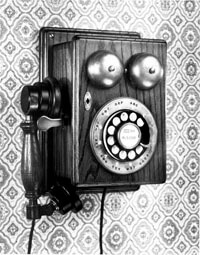
An example of a dial telephone–The Country Junction®, one of AT&T’s Design Line series, c.1975 (THG file photo).
Don’t Touch that Dial! (Dial? What’s That?)
Soon after Almon Strowger developed the automatic exchange, improvements were made that allowed the system to call far more people and in a much more efficient and less cumbersome (wiring-wise) manner.
The first Strowger phones used keys, which were then each wired in a complicated scheme to send the proper signals down the line to the automated switchboard. Rotary dial phones were invented in 1896 by Strowger and his Automatic Telephone Company. These phones became the primary kind of phone all the way through the 1970s.
Dial phones all work the same way. The rotary dial was set to create a certain number of interruptions in the electric current flowing through the phone wires depending on how far around it was turned; thus, if you stuck your finger through the hole over the “6,” then pulled the dial as far as it would go with your finger still in the hole, then released it, the dial would create six electric interruptions on its way back to the starting position.
These interruptions were detected by the automatic equipment at the telephone exchange and interpreted as a phone number. In fact, they still are—even though most phones have moved on to touch tone dialing (using tones instead of interruptions in the electric current to signal the exchange), telephone exchanges are still set up to properly route calls made with a non-electric rotary dial.
Enter the 21st Century
Amazingly, changes around the base telephone technology have been far more prevalent than changes to the basic technology itself. Phones are now equipped with circuit boards and various electronics that take the place of rotary dials, but the idea is the same (to send a signal to the exchange to tell it what number you’re dialing). The microphone and receiver may be made of the same membrane-carbon-electromagnet assembly they’ve been made of for years, or they may create the variance in electric current in some other fashion, but there is always a membrane which vibrates due to the sound of your voice and electric current varying because of it. And the electric current may be converted to an FM radio signal before being broadcast to your cordless or cell phone, but it’s still the same variance in the current (or signal) that carries your voice. The telephone has been an incredibly durable and important technology for over one hundred years, and it promises more of the same for the foreseeable future.
References
Here are just a few of the many resources on the Web that includes bits or lots of telephone history. We found these the most useful.

